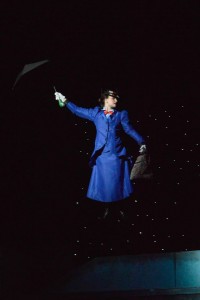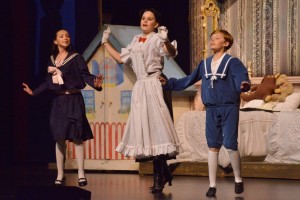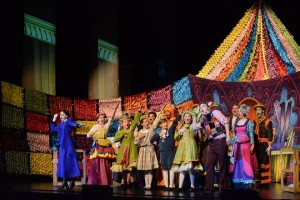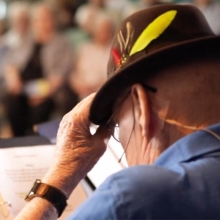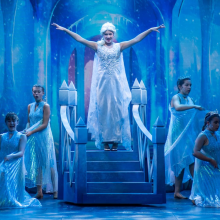Filichia Features: Mary’s Eye-Poppin’ at Green Valley High
Filichia Features: Mary’s Eye-Poppin’ at Green Valley High
Photo by John Nollendorfs.
At the Thespian Festival in Lincoln, Nebraska, communal lunches may be common, but the conversations among participants is choice.
I was sitting near a middle-aged man who’s one of the dozens of high school drama directors here. Said he, “I’ve been directing shows for so many, many years now – decades, really – so it’s now at the point where I really need a challenge.”
A few hours later, I saw Mary Poppins, brought to us courtesy of Green Valley High School in Henderson, Nevada. While I spent the rest of the festival keeping an eye out for that unchallenged director, I couldn’t find him among the literally 4,000 attendees. But if you’re reading this, sir: my, have I got a challenge for you.
Actually, the 2006 Broadway smash offered plenty of challenges for crackerjack director Jennifer Hemme. And yet, she emerged so triumphant that the show should have been retitled Mary Eye-Poppin'.
Of course any director would have no challenge in selling the show, for Mary Poppins is a brand name that has been around for more than 80 years. Her first appearance came as a result of Ms. P.L. Travers’ many books, but it took Walt Disney, Julie Andrews, the Sherman Brothers and two seldom-mentioned screenwriters (Bill Walsh and Don Da Gradi) to vault her to super-stardom in 1964.
Aside from giving you an easy sell, Mary Poppins will make you roll up your sleeves. While there are ways to do it less ornately than Hemme did, this is a big show. Steve Huntsman shrewdly designed a house for the Banks Family that unfolded the way that Tevye’s did in the original production of Fiddler On The Roof. That helped.
But what of that scene in which one table leg must collapse, shelves fall and pictures drop from the wall? Hemme easily managed it. And to think that all that’s collapsed must be put right again in a nonce. I’ll repeat myself: Hemme easily managed it.
Mary Poppins demands many other special effects – and we’re not just talking about the sound of a dog barking. Think about the trick which has Mary put her carpetbag on the bed, open it, and pull out everything including a tall hat-rack. Yes, Hemme had a student situated under the bed to make that happen.
You’ve heard that in the original Broadway production Mary Poppins flew across the stage and, at the end of the show, high over the audience. Hemme didn’t quite deliver on the second stunt – life’s hard enough – but she certainly had Alexa Freeman fly through the air with the greatest of ease, thanks to two very secure wires. When time came for Miss Andrew, the sinister substitute nanny, to take her leave, Hemme put her in a cage and had her fly out, too.
Photo by John Nollendorfs.
Of course every Broadway audience who was at the New Amsterdam Theatre on any date from November, 2006 to March, 2013 came out of the theater raving about the coup de théâtre in which Mary’s pal Bert was 1) hooked up to wires 2) walked up the stage left proscenium arch to the top 3) spanned the entire distance of the stage while walking upside down and 4) walked down the stage right proscenium arch to the bottom. Surely Hemme wouldn’t make young Josh Wride try that.
Oh, yeah? I’ll admit I was pretty frightened when Wride started his climb – much more scared, apparently, than Wride was himself. He made it look like a jolly holiday without Mary. To be sure, every actor’s dream is to be center stage, but few have ever thought about being there dozens of feet above the action while hanging upside down from wires and singing a long sustained big note.
Broadway’s “Jolly Holiday” had bronzed statues come alive, but Hemme had three kids completely silvered (well, aside from their palms; perhaps the directed had learned from Goldfinger or A Chorus Line that skin needs room to breathe). There were plenty of parasols and kites making for a most jolly holiday, until the rain came – albeit “only” as a projection on the backdrop. Oh, well; at least Queen Victoria showed up. (There’s another costume you’ll need.)
By the way, once that scene had ended, a descending scrim accidentally hit one umbrella and jarred it out of an ensemble member’s hands. The audience winced until one boy ad-libbed “Anything can happen,” citing a song we’d hear much later. Of course he got a hand, which he deserved. But there’s another lesson to be learned here: it showed that the boy was quick-thinking, a skill that he may very well have developed from being in live stage shows. Who knows how many times and in how many future situations this ad-libbing skill will serve him for the rest of his life?
Photo by John Nollendorfs.
As for other needed-for-life skills, there are a few waltzes that dancers must master; this will prepare many boys for the many future wedding receptions they’ll attend, including the one in which they’ll have to dance to “Daddy’s Little Girl” with their daughters.
But choreographer Greg Kata couldn’t just waltz through the show. There are a half-dozen production numbers that involve plenty of kids. One is an immense challenge: “Supercalifragilisticexpialidocious” which asks its many participants to do a different gesture for each of the 14 syllables. Green Valley’s kids were all in synch during the entire experience.
Elaborate cycloramas from Grosh Backdrops and Drapery in Los Angeles contrasted nicely with the $9.99 paintings that served as examples of Bert’s work. And the costumes! Perhaps there are some Victorian-era clothes hanging around your costume shop or relatives’ attics, but you will need plenty that are even harder to come by. One scene required as many fairy tale characters as there are in all of Mother Goose. And Mother of Goose, you’ll need many more duds. Costumers Bob Love and – yes -- Jennifer Hemme found and/or built no fewer than two dozen chimneysweep outfits for “Step in Time” (which must take its place as one of Broadway’s greatest eleven o’clock numbers). The sweeps were in black outfits and red scarves which dovetailed nicely with Mary’s red outfit that sported a touch of black.
Hemme’s cast reigned sovereign over Cherry Tree Lane. Any lass cast as Mary Poppins must show a heart along with her immense power and authority, and Alexa Freeman did, adding a marvelous sense of spirit when she walked. You need a light-on-his-feet leading man, which Josh Wride provided. Bert must be adept at dancing with a broom, making it a veritable dance partner, and Wride was an excellent Fred to the broom’s Ginger.
There are potent roles for other kids, too. Here, Taylor Powers got two of them thanks to her glorious voice: Bird Woman who delivers “Feed the Birds” and Miss Andrew, the nanny from Hades who shares two airings of “Brimstone and Treacle.” Don’t forget the many Cockneys in the cast, which means you ‘ave to ‘ave kids who are dropping “h’s” everywhere (although they must “halways” add them to words beginning with vowels).
Even if you only have the resources to do a bare-bones, vest-pocket Mary Poppins, it might be worth doing. A story of a too-busy father who can’t even make time to give his wife a peck of a kiss has been increasingly relevant for a few decades. Perhaps less-than-attentive fathers who attend will mend their ways.
At the same time, kids also learn from the show that adults have responsibilities and can’t be available at each and every moment. For that reason, Mr. Banks must not come across as an unfeeling man, but a preoccupied one. He must show the concern of knowing that four people are depending on him (including Mary Poppins herself) and that he cannot fail them. Alex Rusche accomplished this nicely and was rewarded with audience sympathy. When he finally and unapologetically embraced his wife (the wondrous Aubrey Williams), the kids in the audience awwwwed in affectionate awe.
I’ll echo Mary’s oft-heard warning, “Be careful what you wish for” to that aforementioned director who said he wants a challenge and to everyone else. But if you do well by Mary Poppins, you’ll be rewarded with the wide-eyed looks of admiration and high-pitched appreciative cries of “This is the best high school production I have ever, ever, ever seen!” That was Hemme’s happy fate for the rest of the week. For years to come, many a person meeting her at the Thespian Festival will put a hand over heart before saying breathlessly “You’re the one who did that sensational Mary Poppins?! Let me shake your hand!”
Photo by John Nollendorfs.
To get raves, you must do a rave-worthy show. If you’re a tired high school drama teacher who just wants to get by (and I certainly didn’t see even one at the festival), well, do a four-person revue and afterward you’ll greet parents who’ll perfunctorily smile and offer such “compliments” as “Yeah, that was nice.”
But to paraphrase a famous Stephen Sondheim lyric, “Nice is different from great.” And greatness is what Mary Poppins requires. If you need time to think, well, the show isn’t quite ready for licensing – although it should be before Christmas. That gives you a little extra time to plan a production that will give yourself, your kids and your audience a present that’s tantamount to a jolly holiday.

You may e-mail Peter at pfilichia@aol.com. Check out his weekly column each Tuesday at www.masterworksbroadway.com and each Friday at www.kritzerland.com. His new book, Strippers, Showgirls, and Sharks – a Very Opinionated History of the Broadway Musicals That Did Not Win the Tony Award is now available at www.amazon.com.
